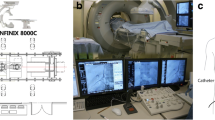Summary
Introduction: Coronary arterty disease still remains the primary cause of death in the western industrialized world. Although the clinical value of selective coronary angiography (SCA) is beyond dispute, the associated risk of an invasive approach, the inherent costs and the necessary hospitalization have lead to the development and investigation of novel non-invasive techniques for coronary imaging. Intravenous coronary angiography (ICA) has been shown to permit non-invasive imaging of the coronary arteries.
Methods: In 66 pts (80% male, age 62 (± 8.5 years) after interventional therapy/CABG operation, ICA and a SCA were carried out within a time interval of < 6 weeks. After determination of the individual circulation time, contrast media (370 mg iodine/ml, 15 ml/s, 21 ml) was injected via a sheath in the cubital vein while the patient was sitting in an upright position in a specially designed scanning chair. In two differet projections 6–8 images/patient were obtained for further image processing and evaluation. 182 target vessels had to be evaluated (LAD 55, Cfx 21, RCA 54, Grafts 52). In 50 target vessels one or more stents were implanted.
Results: 182 target vessels were evaluated according to the following criteria: no stenosis, < 70%, > = 70%, occlusion. Evaluation of the ICA and SCA images was performed by two independent investigators. Due to poor image quality, 17 vessels were not evaluated. The ICA findings were compared to that of SCA. For the LAD a sensitivity of 84% (specificity 93%), for the RCA a sensitivity of 85% (specificity 97%), for the Cfx a sensitivity of 67% (specificity 90%), and for grafts a sensitivity of 85% (specificity 97%) was calculated.
Conclusion: ICA proved to be a feasible and safe technique for follow-up after coronary intervention/CABG operation on an outpatient basis. Evaluation of stents and severe calcification is possible. A good image quality provided, LAD RCA and grafts can be evaluated with an acceptable sensitivity and specifity. Due to superimpositioning the low sensitivity for the Cfx has to be compensated by further image processing.
Zusammenfassung
Einleitung: Obwohl die Bedeutung der selektiven Koronarangiographie (SCA) in der Diagnostik der koronaren Herzkrankheit unumstritten ist, ergibt sich aus der Invasivität mit den möglichen assoziierten Komplikationen, evtl. resultierenden Folgekosten und dem in den meisten Fällen notwendigen eintägigen Krankenhausaufenthalt der Bedarf für neue, nichtinvasive Techniken im Bereich der Koronardiagnostik. Mit der intravenösen Koronarangiographie mit Synchrotronstrahlung (ICA) steht ein Verfahren zur Verfügung, welches die nichtinvasive Darstellung der Koronararterien und Stents ohne Artefakte erlaubt.
Methodik: 66 Patienten (80% männlich, Alter 62 ± 8.5 Jahre) nach Koronarintervention bzw. CABG-Operation wurden innerhalb von maximal 6 Wochen mittels SCA und ICA untersucht. Nach Applikation eines Kontrastmittels (370 mg Jod/ml, 15 ml/s, 30 ml) durch eine 6 F (7 F)-Schleuse in der V. brachialis wurde in 2 unterschiedlichen Projektionen 6–8 Bilder/Patient akquiriert. Zielgefäße für die Evaluation waren: LAD n = 55, Cfx n = 21, RCA n = 54, CABG n = 52. In 50 Zielgefäßen waren ein oder mehr Stents implantiert.
Ergebnisse: 182 Gefäße wurden nach folgenden Kriterien beurteilt: Keine Stenose, < 70%, > 70% und Okklusion. Die Beurteilung der ICA-Befunde und der SCA erfolgte durch zwei unabhängige Untersucher. Die Ergebnisse der ICA wurden mit denen der SCA verglichen. Wegen schlechter Bildqualität konnten n = 17 Gefäße nicht beurteilt werden. Folgende Sensitivität/Spezifität für die einzelnen Koronargefäße wurden errechnet: LAD 84%/93%, RCA 85%/97%, Cfx 67%/90%, Grafts 85%/97%.
Schlußfolgerungen: Es konnte gezeigt werden, daß ICA eine durchführbare und sichere Technik für das ambulante Follow-up von Patienten nach PTCA/Stentimplantation und CABG-OP darstellt. Im Gegensatz zu anderen nichtinvasiven Techniken ist die Beurteilung auch bei Stents und Kalzifikationen möglich. Bei guter Bildqualität lassen sich weitgehend überlagerungsfrei projizierbaren Gefäße (LAD, RCA, Grafts) mit akzeptabler Sensitivität und Spezifität darstellen. Die niedrige Sensitivität bei der Darstellung der Cfx aufgrund von Überlagerung durch den linken Ventrikel muß durch weitere Entwicklungen im Bereich der Bildverarbeitung kompensiert werden.
Similar content being viewed by others
Author information
Authors and Affiliations
Rights and permissions
About this article
Cite this article
Dill, T., Job, H., Dix, WR. et al. Intravenöse Koronarangiographie mit Synchrotronstrahlung. Z Kardiol 89 (Suppl 1), S027–S033 (2000). https://doi.org/10.1007/s003920070120
Issue Date:
DOI: https://doi.org/10.1007/s003920070120




